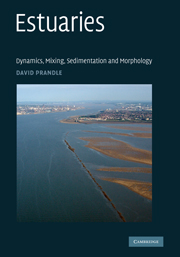Book contents
- Frontmatter
- Contents
- List of symbols
- 1 Introduction
- 2 Tidal dynamics
- 3 Currents
- 4 Saline intrusion
- 5 Sediment regimes
- 6 Synchronous estuaries: dynamics, saline intrusion and bathymetry
- 7 Synchronous estuaries: sediment trapping and sorting – stable morphology
- 8 Strategies for sustainability
- Index
- References
1 - Introduction
Published online by Cambridge University Press: 01 September 2009
- Frontmatter
- Contents
- List of symbols
- 1 Introduction
- 2 Tidal dynamics
- 3 Currents
- 4 Saline intrusion
- 5 Sediment regimes
- 6 Synchronous estuaries: dynamics, saline intrusion and bathymetry
- 7 Synchronous estuaries: sediment trapping and sorting – stable morphology
- 8 Strategies for sustainability
- Index
- References
Summary
Objectives and scope
This book aims to provide students, researchers, practising engineers and managers access to state-of-the-art knowledge, practical formulae and new hypotheses covering dynamics, mixing, sediment regimes and morphological evolution in estuaries. Many of these new developments assume strong tidal action; hence, the emphasis is on meso- and macro-tidal estuaries (i.e. tidal amplitudes at the mouth greater than 1 m).
For students and researchers, this book provides deductive descriptions of theoretical derivations, starting from basic dynamics through to the latest research publications. For engineers and managers, specific developments are presented in the form of new formulae encapsulated within generalised Theoretical Frameworks.
Each chapter is presented in a ‘stand-alone’ style and ends with a concise ‘Summary of Results and Guidelines for Application’ outlining the issues involved, the approach, salient results and how these can be used in practical terms. The goal throughout is to explain governing processes in a generalised form and synthesise results into guideline Frameworks. These provide perspectives to interpret and intercompare the history and conditions in any specific estuary against comparable experience elsewhere. Thus, a background can be established for developing monitoring strategies and commissioning of modelling studies to address immediate issues alongside longer-term concerns about impacts of global climate change.
Processes
Estuaries are where ‘fresh’ river water and saline sea water mix.
- Type
- Chapter
- Information
- EstuariesDynamics, Mixing, Sedimentation and Morphology, pp. 1 - 22Publisher: Cambridge University PressPrint publication year: 2009



